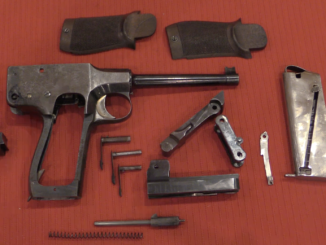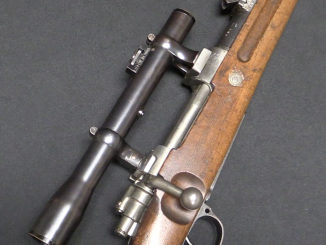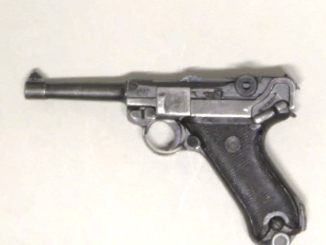This pistol is one of just a couple surviving from a development project run by Walther in the mid to late 1930s. The goal was to produce a compact sidearm for pilots and officers using a more potent cartridge than the .32ACP or .380. To do this, Walther split the dimensional difference on case length and developed the 9x18mm cartridge, which would later be known as 9mm Police or 9mm Ultra. It used a standard .355 inch bullet, but split the ballistic difference between 9×17 Browning and 9×19 Parabellum.
The early developmental testing was done by simply chambering a PP for the new cartridge, but it proved a bit too powerful for the simple blowback action of the PP. So this was followed by the development of the pistol we have today, which integrated a short recoil, rotating barrel locking system to meet the demands of the new cartridge. By this time, however, it was 1939, and the importance of the project was dwarfed by the rapidly accumulating wartime production needs of the German military. The gun was dropped, although the cartridge would be reintroduced after the war.
For more information on the project, and all of Walther’s other work, see “Walther: A German Legend” at Amazon:




It should be impossible not to appreciate what a fertile company Walther was. Just say a different gun to the staff and it was ready after a reasonable time past. Nowadays, same company plays the scenario of “Back to the future”. Newest pistol CCP M2 uses nearly the same take down used in Walter Model 9 made nearly a hundred years ago as an improved version on the first model of CCP.
Nice work Ian – Forgotten Weapons has shown a definite knack for finding out detailed information about firearms, etc that I had no idea about. It’s one thing to be entertained, and another to be entertained and educated at the same time.
BTW the “Forgotten History” is also excellent and (to me) a very welcome addition.
Would you consider a “Forgotten History” about Little Big Horn (AKA Battle of the Greasy Grass)? There has been a great deal of ballistic/forensic analysis of the battle and it would be fascinating if you applied your approach to that incident.
I think that might be something that Inrange (a channel that he also is part of) has done.
Pistol looks well made but having a cumbersome take down. Usual PP Swinging trigger guard seems as the key part of the process but requires a pin push to be released. Its upper lug seems rotating guide for the barrel. Smaller pin in the front seems the the barrel recoiled back retainer. The gun seems a clever approach to convert the blowback PP to locked breech, but not a practical one.
Lovely pistol, but too small for military. In my knowledge the only German pistol, part of J.Nickel’s design (which became vz.22/24), with rotary lockup.
Ah but Denny, the Germans–always with a surfeit of pistols!–did issue tons of pistols that were entirely too small for the military and combat utility. So too France and other WWI powers with Ruby 7,65mm pistols, lacking interchangeable parts, etc. The makes and models of the Wehrmacht, SS, Luftwaffe, and Kriegsmarine is truly bewildering.
“too small”
If I am not mistaken project Ultra was linked with Luftwaffe, for them small but relative powerful automatic pistol would make sense (ballistic-wise it would be similar to S&W Victory revolvers in .38 caliber used by U.S. Navy airmen) and anyway they ended with 7,65 mm Browning [.32 Auto] as standard and using wide gamut of various automatic pistol, including such exotics as Pistole 37(u) that is variant of Hungarian Frommer automatic pistol firing 7,65 mm Browning [.32 Auto].
I am wondering who was responsible for Ultra project development at Luftwaffe side?
9×18 Ultra/Police cartridge has bad luck for unfavourable times twice: in 1930s with war raging on there was not place for new cartridge and in 1970s with terrorism acts (see for example München 1972) was not good times for cartridge bit more powerful than 9×17 mm Kurz [.380 Auto] intended for police use.
Very true. By the time the Walther PP Super was introduced (the only other pistol ever chambered for 9 x 18 Ultra as far as I know), the police in West Germany and elsewhere were concerned about the use of body armor by both terrorists and professional criminals, who often had access to the same protective vests the police used by the “anything is available for the right price” route.
As such, the police across Western Europe moved from 7.65mm Browning and 9mm Short to 9 x 19mm Parabellum. The only exception was the French national gendarmerie’, who had already been using the MAS 1950 in 9 x 19mm for decades by that point; they went to the Manhurin MR-73 revolver in .357 Magnum. Eventually, they settled on a French-built variant of the Beretta M92, but loaded it with what would be called “+P+” rounds in the U.S.
The 9 x 18 Ultra just had the bad luck to be introduced twice at times when the already existing 9 x 19mm would be what everybody really wanted. It stands to the 9 x 19mm as the .41 Remington Magnum stands to the .44 Remington Magnum; offering less than an already-existing cartridge. That rarely sells unless the already-existing one is just too much for the job.
This was the fate that also befell the 10mm Auto when the .40 S&W was introduced in U.S. police circles. And the latter is now fading into obscurity as well, ironically being succeeded by…the 9 x 19mm.
cheers
eon
“only other pistol ever chambered for 9 x 18 Ultra as far as I know”
9×18 Ultra also known as Police, was also available in:
SIG-Sauer P230: http://modernfirearms.net/en/handguns/handguns-en/switzerland-semi-automatic-pistols/sig-sauer-p230-p232-eng/
Benelli B82: http://modernfirearms.net/en/handguns/handguns-en/italy-semi-automatic-pistols/benelli-b76-eng/
Makes sense; space in cockpit comes at premium, any time in history of flying.
“rotary”
While not German, despite what its name suggest, I think it is interesting to point Mauser M2: http://modernfirearms.net/en/handguns/handguns-en/germany-semi-automatic-pistols/mauser-m2-eng/
As it use Mauser name, that is same name as company for which Josef Nickl worked.
I wish to see the internals again and little closer (which may not happen…). There is very little space between ejection port and front of slide where the mechanism can be located. Also, I am noticing the rotation is small; my guess is at around 30 degree. With less potent round it may have been enough.
“With less potent round it may have been enough.”
Wait. Now I am confused. I always though how strong cartridge could be used is defined by area of contact between appropriate elements, not rotation angle itself.
Anyway, if they were unable to make blow-back operated with then available technology for that cartridge it was logical to terminate further works.
Greater contact lock area produced by greater rotation makes for lesser bearing stress and vice versa. Less potent round may not need therefore that big rotation. This is only part of equation since the longitudinal space plays into it too (camming angle is typically held at 45 deg.).
See;
https://www.amazon.com/Know-Your-Walther-Ppk-Pistols/dp/0941540030
by E.J. Hoffschmidt. It includes a two-page spread on this pistol including an exploded view.
Hoffschmidt’s drawing is also found on p. 675 of Handguns of the World by Ezell.
cheers
eon